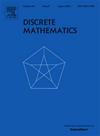Three classes of propagation rules for generalized Reed-Solomon codes and their applications to EAQECCs
IF 0.7
3区 数学
Q2 MATHEMATICS
引用次数: 0
Abstract
In this paper, we study the Hermitian hulls of generalized Reed-Solomon (GRS) codes over finite fields. For a given class of GRS codes, by extending the length, increasing the dimension, and extending the length and increasing the dimension at the same time, we obtain three classes of GRS codes with Hermitian hulls of arbitrary dimensions. Furthermore, based on some known -ary Hermitian self-orthogonal GRS codes with dimension , we obtain several classes of -ary maximum distance separable (MDS) codes with Hermitian hulls of arbitrary dimensions. It is worth noting that the dimension of these MDS codes can be taken from q to , and the parameters of these MDS codes can be more flexible by propagation rules. As an application, we derive three new propagation rules for MDS entanglement-assisted quantum error correction codes (EAQECCs) constructed from GRS codes. Then, from the presently known GRS codes with Hermitian hulls, we can directly obtain many MDS EAQECCs with more flexible parameters. Finally, we present several new classes of (MDS) EAQECCs with flexible parameters, and the distance of these codes can be taken from to .
求助全文
约1分钟内获得全文
求助全文
来源期刊

Discrete Mathematics
数学-数学
CiteScore
1.50
自引率
12.50%
发文量
424
审稿时长
6 months
期刊介绍:
Discrete Mathematics provides a common forum for significant research in many areas of discrete mathematics and combinatorics. Among the fields covered by Discrete Mathematics are graph and hypergraph theory, enumeration, coding theory, block designs, the combinatorics of partially ordered sets, extremal set theory, matroid theory, algebraic combinatorics, discrete geometry, matrices, and discrete probability theory.
Items in the journal include research articles (Contributions or Notes, depending on length) and survey/expository articles (Perspectives). Efforts are made to process the submission of Notes (short articles) quickly. The Perspectives section features expository articles accessible to a broad audience that cast new light or present unifying points of view on well-known or insufficiently-known topics.
 求助内容:
求助内容: 应助结果提醒方式:
应助结果提醒方式:


